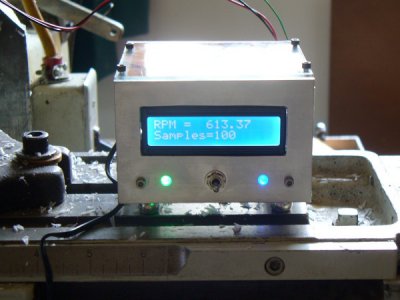I built a simple tachometer using a Hall Effect magnetic sensor and an arduino (AVR) microcontroller. This project is easy enough for a beginner with one important caveat. The caveat is that you have to have some knowledge of the arduino and its programming. If you have an interest in microcontrollers, there are a lot of options for the beginner. The support I've gotten from the arduino community has been outstanding.
I wanted to measure the rotational speeds of my mills and drill press. All three of my machines have at least two speeds determined by pulley selection. I thought the best approach would be one that would allow to rapidly measure the possible combinations and let me build a table of speeds for each machine. I did not want a permanent tachometer attachment.
In looking on line, I found that the most common approach is stroboscopic. After I'd nearly finished this project, I found that there are simple and cheap stroboscope based devices available. Maybe I could have used one of them but I am happy with what I built.

If anybody is interested, I've attached an OpenOffice presentation that documents what I did. If OpenOffice doesn't work for you, I can try a different format. Also attached is the arduino code.

I wanted to measure the rotational speeds of my mills and drill press. All three of my machines have at least two speeds determined by pulley selection. I thought the best approach would be one that would allow to rapidly measure the possible combinations and let me build a table of speeds for each machine. I did not want a permanent tachometer attachment.
In looking on line, I found that the most common approach is stroboscopic. After I'd nearly finished this project, I found that there are simple and cheap stroboscope based devices available. Maybe I could have used one of them but I am happy with what I built.

If anybody is interested, I've attached an OpenOffice presentation that documents what I did. If OpenOffice doesn't work for you, I can try a different format. Also attached is the arduino code.

